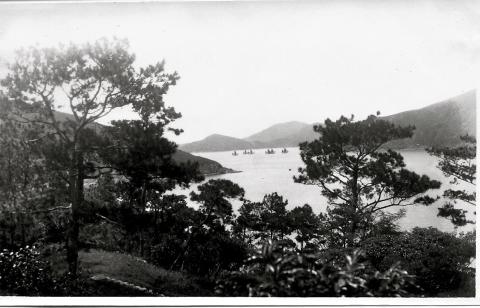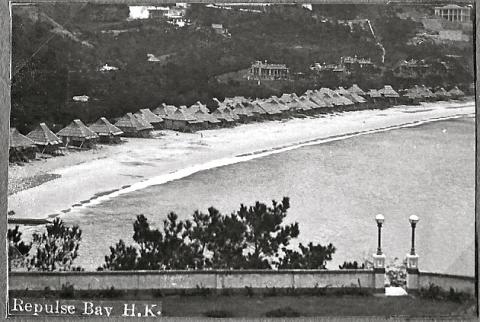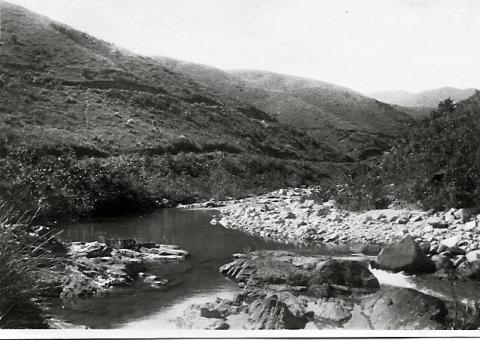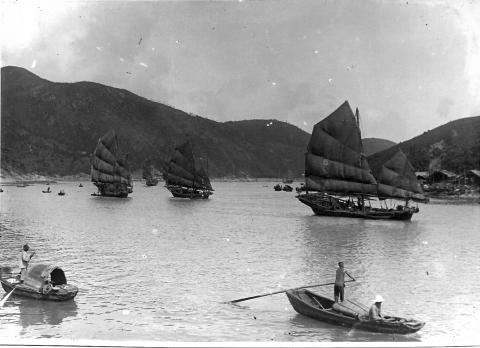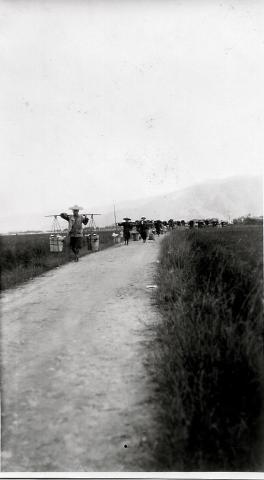The "Drive round the island" was traditional. Hire-cars were stationed outside the Hong Kong hotel, driven by Indians or Chinese. In those days cars ran slowly, so that one could enjoy the colourful scenery and the very winding road without being tossed about. Around the small island, only 32 square miles, the road curved all the way. At night it was a romantic drive, past hollows in the hillside twinkling withfireflies; and fishing boats, with their bright lights reflected in the calm sea.
All day launch picnics were popular in the summer months. Several firms owned steam launches, used on weekdays for business with visiting ships; and on Sundays or holidays they could be hired by the firm's bachelors for picnics. One of these launches was the "Taimoshan" owned by the A.P.C. (Asiatic Petroleum Co.). These launches had their own Chinese coxwains and crews, who on picnic days were joined by perhaps the No. 1 Boy and the No. 2 Boy of the bachelors' mess concerned, bringing the food and drinks for the party. We boarded the launch atBlake Pier in the morning and set off down the harbour, sitting on cane chairs on deck enjoying the sea breezes. As soon as we had left Lyemun Pass and were in fairly open sea, out would come the surfboards, attached by long ropes to the stern of the launch, and those who enjoyed surfboarding were towed along, clinging on to the ropes, twisting and turning and being thrown into the sea, so that we had to turn around and go to their rescue. I never took part in this adventurous exercise.
On arrival at the chosen bay, we anchored and a rowing boat was launched to take some of the party ashore, while others swam to thebeach. Glorious days of warm seas - but we had to be careful not to stay out in the hot sun for too long! Our picnic tiffin was eaten on deck at a large table - what could be more perfect?
Deep Water Bay
The three favourite beaches for launch picnics were at Junk Bay, Clear Water Bay and Big Wave Bay, where the waves really were big on mostdays, and one had the fun of leaping over each one as it swept in, or of being overwhelmed by it if one's timing was wrong. Each beach was more gorgeous than the other, with its dazzling white sand.
Sometimes we went moonlight bathing at Repulse Bay. It was strange and romantic under the moon and stars, swimming in a sea still warm from the sun, with the glitter of phosphorescence surrounding us.
Repulse Bay, then two of the old Repulse Bay Hotel
There would come a Sunday when the sea was full of jelly bugs that pricked our bodies, and we knew it was the end of the swimming season.
The ground floor lounge of the Hong Kong Hotel was a popular meeting place for tea, and the first floor lounge for drinks, with its comfortable sofas and chairs. Adjoining this lounge was the dining room, where the food must surely have been the best in the world, the cooking a combination of French and Chinese, not forgetting the splendid Malay curries - what more need be said? An orchestra played light music at tea time.
We used to meet Kathleen or Eve at the Hong Kong Hotel for tea, or for a meal at Mac's Cafe next door, the first Grill Room Hong Kong ever had. And often we and Kathleen would have Chinese chow on the roof garden of the South China Restaurant in China Building. Besides the dining rooms indoors, you could eat in little summer houses out on the open roof, in a garden of pot plants. It was a delightful place on a summer's evening, looking out on the lights of the Peak and the town. While we were choosing our meal from the vast menu, a Boy brought us damp hot scented towels to wipe our hands on; and we ate "kwa chee" - melon seeds-while waiting for our meal. Some of our favourite dishes were chicken and walnuts, fried garoupa, sweet and sour pork, roasted duckskin, corn soup and "chow fan" - fried rice. Never was food so good! The next day Kathleen complained of indigestion but she said it was worth it, and soon we would be visiting the South China again! I must not forget to mention the "chow mein" - crispy noodles!
I bought my first folding camera, a Kodak with a bellows, from Gordon Frisque, the young American representative of Kodak in Hong Kong. We drove out to the countryside near Kowloon City, and he showed me how to take photographs. And so I became a dedicated photographer.
Some of our friends were Naval and Army officers. Richard Burston, a Lieutenant R.N. on the Commodore's staff, used to invite us to dine on board HMS Tamar, the shore based ship alongside the Naval Dockyard. And we went to dances on board H.M. ships which were gaily decorated with flags for the occasion. John Kealy of the Queen's Royal Regiment and Desmond Finney of the Beds and Herts (Bedfordshire and Hertfordshire Regiment) took me out sometimes, and later Margaret, Audrey and I got to know some extremely wild officers of the Argyll and Sutherland Highlanders. Margaret was sentimental. She loved the poems of Rupert Brooke (and "You are my heart's delight" was a favourite song of hers.
Kathleen met and fell in love with Bill Telfer, a Scotsman in Butterfield and Swire. But he was soon posted to one of the treaty ports. I used to take photographs of Kathleen to send to him. There was a happy ending when they were married in Peking a few years later.
On November llth, Armistice or Poppy Day, we sold poppies in the town in aid of ex-servicemen of the 1914-1918 War, and then attended the Service of Remembrance at the Cenotaph in Statue Square. This was Autumn in Hong Kong. Up till then we had worn cotton summer dresses, but on Poppy Day we put on our new long sleeved silk dresses that the tailor had made.We were sorry to see the end of our 90° summer! But the Hong Kong winter was delightful too, when I think the temperature never fell below 42°.
Douglas Munton, "Munts", had a house in Homuntin, Kowloon. I used to dine there occasionally with Mamma. His servants consisted of cookboy, coolie and wash amah.
On Sundays or holidays I sometimes went with Mamma and Munts for a drive in the New Territories in his car, and a picnic. These were the most happy days for me. It was heaven to be in the countryside; hills all around us, Chinese villages, some of them walled and moated, temples with curved roofs, Chinese graves set in the hillsides, ancient banyan trees with joss sticks burning under them, bamboo groves, pine trees, flowering shrubs growing wild, padi fields on the level and climbing up hillsides, at one season all wet, at another bright green with young rice shoots, women working at all kinds of tasks, their babies tied to their backs, little boys in charge of water buffaloes, usually riding on their broad backs, girls washing clothes in streams, pigs with curved backs, their stomachs touching the ground, chickens, ducks being led to a pond by a man with a stick, Hakka women in their large curtained hats.
One of our favourite picnic places was the Shing Mun River Valley, enclosed by hills and dominated by the highest, Tai Mo Shan; a beautiful place of pines, wild gardenias and camellias, ferns, barley bues and wild roses. This valley was doomed to become another of the many reservoirs providing the Colony with water.
Shing Mun River
I think it took about four hours to make the circle of the New Territories by car. You drove from Kowloon by the Lai Chi Kok Pass, past the Amah Rock, a formation resembling an amah with a baby on her back, to Shatin, and then beside Tide Cove, an inlet of the sea leading to Tolo Harbour - grand views here of islands and the open sea, and of Ma On Shan towering over to the east. Near here was Mirs Bay, in earlier days the haunt of pirates. Then past Taipo, its harbour crammed with the Hoklo people's junks and sampans, home to these fisher people.
Junks and Sampans
Then inland driving westwards past Fanling and its golf course and across country to the sea on the other side, Deep Bay, and then south past Un Long to Castle Peak, and eastwards back to Kowloon. The New Territories were full of attractive names, Plover Cove, Port Shelter, Gin Drinkers Bay, Pineapple Pass, Smugglers Ridge, Customs Pass, Starling Inlet.
The New Territories
